Electric Chair Hole Protectors:
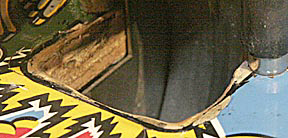
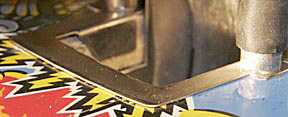

Odds And Ends Assorted ruminations on the Addams Family pinball game that don't fit on any of my other pages.
Electric
Chair Hole Protectors:


I read and Internet article that claimed that while these protectors are good for the table, the make the chair hole smaller and because of their sharper edge curvature they offer the funneling effect that the original routed wood hole had. To test this I took statistics of shooting the chair starting with balls stopped at both the left and right flippers with and without the protector. The numbers were the same in both cases, though it for some reason it felt it was harder with the protector in place.
Mechanically, the hole opening without the protector is 1.45-inches wide and 1.40-inches with the protector. This 0.05-inch reduction corresponds to the thickness of 16 sheets of typical typing paper: not much. The curve of the wood before wear is 1/8-inch on radius. With the protector this is reduced to 1/32-inch. Shots fired from the flippers are going so fast that they fly right over both these curves. Only very slowly moving balls drifting along the edge of the hole would find the unprotected hole more inviting. In such cases it's also likely that the slight raised edge of the protector might push them away.
My biggest concern is that the metal edge of the protector might tend to ding the surface of balls fired into the chair, even though the edge of the protector on my game has been beveled a little. I see two solutions to this problem: increase the bevel so that it's more gradual and polish it so that it's smoother; or carve (gulp) a shallow inset around the chair hole that's just deep enough so the top of the protector is level with the field.
Working
under the table:
Some of the nuts under the table are located in places where it's impossible to get your fingers to get a nut started. All my sockets are too deep to hold the nut and let them reach the bolt to start threading it. A quick solution is to stuff a wad of paper toweling into the socket to fill up the bottom half.

This leaves enough socket depth to hold the nut but keeps the nut close enough to the end so that it can reach the bolt.
Old Ball,
New
Ball Comparison:
The following image is a macro photo of one of the balls that came with my TAF:
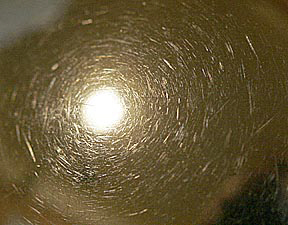
Each of those thousands of scratches tend to slow the ball down and increase table wear. Compare this to the following brand new ball:
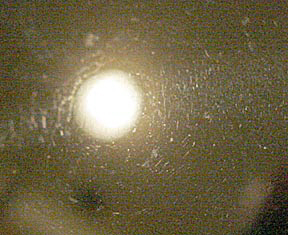
One thing that surprised me about the new balls is how much they speeded up play. It was as if the flippers suddenly had 10-percent more power. It'll be interesting to see how long this lasts.
I examined the playfield and concluded there were really only two places where the balls strike a sharp metal edge hard enough to cause dents like those shown in the picture of the older ball. One is the metal hole protector installed in the electric chair. Although it's leading edge had been beveled a little there was still sufficient lip to ding a ball. The second place is the end of the sheet metal siding that ends between the upper right flipper and the small post located just above the upper swamp target. Shots missing the swamp high have a high risk of slamming into this sharp edge at high velocity.
After playing 100 games I checked the new balls and they were as dinged up as the original balls.
Longevity
One concern many people have about purchasing a pinball machine is that after a month or so it'll become boring. All I can say to this is that after owning my TAF for 15 months and playing it almost every day it's still fun and fascinating to both me and my entire family. There are so many variations in play and strategies that it's hard to imagine ever loosing interest in it.
Major
Design Complaint
As an engineer I know that no matter how well a pinball machine is constructed it will eventually break. Because of this fact the people designing pinball machines have a responsibility to future owners to make the machines easy to disassemble to facilitate repair. In this issue the designers of the Addams Family pinball game failed miserably. While working on the playfield I regularly have to fight my way around playfield plastics that are stacked with offset sequences of screws that render access to screws holding down other pieces of equipment virtually impossible. Worse still, in many cases the only way to attempt gaining access to hidden screws is to remove the only screws you can see, only to discover that these screws thread into nuts that drop off into unrecoverable locations. Many of these units appear to have been preassembled for easy installation without the least consideration for the fact that once installed they are almost impossible to remove. Such design and construction methodologies are short sighted and grossly unfair to future pinball game owners.
Winning the Game
It's impossible to beat a pinball game. No matter how good someone is, eventually fatigue will wear them down and all balls will be lost. By design the games are open-ended so that no matter how high a score you get there is always room for improvement. This is psychologically daunting because it's hard to maintain an aggressive attitude knowing that you are doomed to eventual failure the second you turn the game in.
To address this issue I decided to create an admittedly artificial goal that defines a "win." For myself and my family, you "win" an Addams Family pinball game when you complete a tour of the mansion, regardless of the score. This accomplishment defines a significant and unique milestone in the game and as such serves as an excellent marker of achievement.
Working
Toward Higher Scores:
Having only played pinball four months, I'm not ashamed to confess that my highest score to date is $2.1 billion on a TAF Gold (factory default settings with 5-ball play.) This hardly qualifies me to comment about methods for improving one's scores, particularly since I have yet to see a good player to observe how he or she plays. Also, although I have my own game I would not consider myself as a devoted player. I average less than two games a day and many days I never even turn it on. Based on this admittedly limited expertise, I believe that the key to getting high scores is not in making great saves but in consistently shooting accurate shots so that the ball is always in control. Most of the time when I loose a ball it's because I've missed a shot and the ball ricochets off a bumper too fast for me to recover. Saves are helpful but they necessarily take place near the drain, which is a risky place to be. I do much better playing slowly, maintaining control and making shots to keep the ball as far from the drains as possible.
Avoid high-risk shots like the swamp kickout during Tunnel Hunt. A ball is easily worth more than even the $15M maximum award.
Another key is to study the playfield to know where everything is and what it does in all the rounds. Hand in hand with this is to study the playing guides available on the Internet. Of the dozen people who've played on my Addams Family pinball game I'm the only one who's done both. Everyone else completely ignores the playfield and mansion room round posters I put up next to the game and blindly flail away at the ball with the flippers.
Every successful athlete knows the value of visualization and this technique works in pinball. As a ball approaches a flipper, visualize making the ball hitting its intended target. Doing this helps the mind communicate to your muscles what needs to happen.
Finally, approach the game with a plan. Discover the shots you make with ease and figure out a strategy that uses them the most. Equally important, know your weak shots and build your strategy around avoiding them.
Good luck!
Chrome
Versus
Carbon Steel Balls
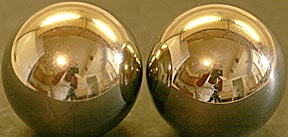
Although it's hard to tell in the photo above, the brand new chrome plated ball on the right is slightly shinier than the equally new plain carbon steel ball on the left. In person the difference is easier to see, though not obvious.
When I needed to replace the balls given to me by the man who restored my TAF, they had rust spots on them, I decided to use the opportunity to compare normal balls to chrome plated balls to see which resisted scratching better. I began by taking close-up photos of each ball before putting them in play:
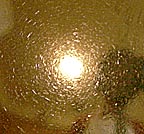 ......
...... 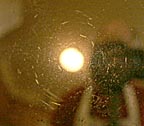
......Carbon
steel ball..............chrome
plated ball.....
The chromed ball is obviously smoother, at least when new. I used each set of balls in the game for a total of 4 hours each. Here's how they look now:
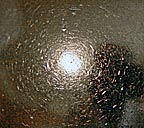 ........
........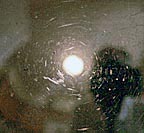
......Carbon
steel ball..............chrome
plated ball.....
Although they both show wear, I appears to me that the chrome plated ball is resisting better. I couldn't distinguish any difference in play between the two types of balls but nonetheless confess to a preference for the chromed balls. They look brighter and shinier.
(Click
on main site
to browse 70 other topics ranging from exotic kaleidoscope designs to
the strange world of lucid dreaming. There you will also find several
other pages dealing with the Addams Family pinball game.)